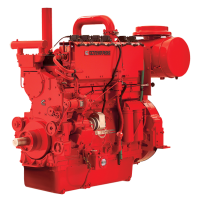
White paper by Nicholas Hawes, CPE Technical Specialist
Jump to: Introduction | Test Results | Summary
Executive Summary
This paper provides results of separate back-to-back tests on QSK95 diesel engines with Ultra Low Sulfur Diesel #2 (ULSD #2) fuel and Hydrotreated Vegetable Oil (HVO) fuel. Testing was performed with a production-built development engine in an engineering test cell (mechanical power for a 60Hz 3500 kWe Standby genset) and in the field with a QSK95 60Hz production genset (3000 kWe Standby genset). No changes or conversions were made to the engines (including ECM calibrations) between testing on the different fuels; the only difference between the two tests is the fuel used to conduct the testing.
The results of this testing can be summarized as follows:
- Exhaust Emissions
- Lower smoke and particulate matter emissions with HVO fuel
- Comparable NOx emissions
- Power and Fuel Consumption:
- Potential for 1-2% lower power with HVO fuel at the engine dataplate Standby mechanical power
- 3-5% higher fuel consumption by volume with HVO fuel
- Transients and Emergency Start Times:
- Comparable transient and emergency start time performance
Cummins has conducted similar testing on other High Horsepower generators and similar performance offsets are expected.
Introduction
Hydrotreated Vegetable Oil (HVO) is a bio-based paraffinic diesel fuel. It is one form of renewable fuel that is produced from vegetable oil and animal fats. The main difference between biodiesel and HVO fuel is the production process for each fuel. Biodiesel is produced through an esterification process and HVO fuel is produced through a hydrotreatment process. Cummins requires paraffinic fuels to meet EN15940 per Fluids for Cummins Products Service Manual (5411406), section 1.
To support customer adoption of HVO fuel, Cummins performed back-to-back testing on Ultra Low Sulfur Diesel #2 (ULSD #2) fuel and HVO fuel in a QSK95 generator set and a QSK95 engineering test cell. This testing aimed to evaluate engine performance and emissions when operating on these fuels.
Cummins has previously tested paraffinic fuels on multiple engines and configurations to support the use of renewable fuels in the field. Examples can be found in the following SAE documents:
- Calibration Optimization of a Heavy-Duty Diesel Engine with GTL Diesel Fuel
- Emissions and Fuel Economy Evaluation from Two Current Technology Heavy-Duty Trucks Operated on HVO and FAME Blends
Fuels Tested
An evaluation of engine performance and emissions was conducted using ULSD #2 fuel and HVO fuel. Engineering tests were performed with R100 HVO fuel. Field tests were performed with R99 HVO fuel. Details on fuel analysis results can be found below:
Test Plan
Steady State:
- D2 5 mode test cycle (100%, 75%, 50%, 25%, and 10% load points)
Transient:
- NFPA110 emergency starts
- ISO 8528-5 load steps
- Custom transient load steps (0%-50%, 50%-100%, 100%-50%, 50%-75 %, 75%-100%, 100%-75%, 75%-50%, 50%-0%, 0%-100%, 100%-0%)
Test Results
The same mechanical powers (engineering test cell) and electrical powers (field test) were targeted for each of the back-to-back tests.
A 3-5% increase in fuel consumption with HVO fuel, as compared to ULSD #2 fuel, was observed during engineering (lab grade equipment fuel meter) and field (fuel tank measurements) tests (see Figure 1).
Due to the lower energy by volume with HVO fuel, a mechanical power loss of 1-2% was observed during engineering testing (see Figure 1). Depending upon the performance variation of the production engine installed in the generator set, this loss might be observed when running at the engine dataplate Standby mechanical power.
- In the generator set application, engine speed/frequency will start to drop before the generator set is no longer able to produce the requested power.
- At power nodes where the available mechanical power (after auxiliary losses and derates) exceeds the generator set electrical power rating, the power loss with HVO fuel may be fully absorbed or reduced.
Figure 1: Fuel Consumption and Power Change with HVO Fuel. Observed fuel consumption and power change when operating with HVO fuel compared to ULSD #2 fuel.
The engineering and field test data show comparable NOx emissions at the D2 5 mode points (see Figure 2). 5% error bars were added to the NOx measurements to account for measurement variation. The following methods were followed for the NOx measurements:
- Engineering test: ISO 8178-1:2006
- Field test: EPA method 7E
Figure 2: NOx Reduction with HVO Fuel (Engineering Test). Observed NOx when operating with HVO fuel compared to ULSD #2 fuel.
Particulate matter emissions were reduced 30-60% with HVO fuel as compared to ULSD #2 at the D2 5 mode points during engineering tests (see Figure 3). 10% error bars were added to the PM measurements to account for measurement variation. A 20-30% reduction in PM using HVO fuel as compared to ULSD #2 was observed in the field at modes 1 and 2 (100% and 75% load). A reduction in PM aligns with the minimal aromatic content of HVO fuel. The sensitivity of particulate matter measurements along with differences in performance parts may result in field measurements outside of this range. The following methods were followed for the particulate matter measurements:
- Engineering testing: ISO 8178-1:2006
- Field test: EPA methods 5 and 202
Figure 3: PM Reduction with HVO Fuel (Engineering Test). Observed PM when operating with HVO fuel compared to ULSD #2 fuel.
Smoke emissions were measured during engineering testing with an AVL 415 smoke meter. The reduction in smoke emissions with HVO fuel as compared to ULSD #2 followed the same trend as particulate matter emissions.
Transient and emergency testing was performed at 1.0 Power Factor and 480 Volts. Comparable transient performance between HVO and ULSD #2 fuel were observed when running the ISO 8528-5 and part load steps (see Figures 4 and 5). Emergency start time performance also showed comparable performance between the 2 fuels.
Notes for the results above: Test results are based on the use of R100 HVO fuel during the engineering test and R99 HVO fuel during the genset field test. Sensitivity to all HVO fuel blends is not known at this time on the QSK95. Steady state emissions were recorded per ISO8178-1 during operation at rated engine speed (+/-2% ) and stated constant load (+/-2%) with engine temperatures, pressures and emission rates stabilized. This data is subject to instrumentation and engine-to-engine variability. Field emissions test data is not guaranteed to these levels. Actual field test results may vary due to several factors, including test ambient temperature, site conditions, installation, fuel specification, test procedures, instrumentation, and ambient correction factors. Engine operation with excessive air intake or exhaust restriction beyond published maximum limits, or with improper maintenance, may result in elevated emission levels.
Figure 4: QSK95 60Hz 3000 kWe Field Test ISO Load Steps. Observed genset frequency under ISO load steps when operating with HVO fuel compared to ULSD #2 fuel.
Figure 5: QSK95 60 Hz 3000 kW Frequency Excursion with Custom Load Steps. Observed genset frequency under custom load steps when operating with HVO fuel compared to ULSD #2 fuel.
Summary
Testing on the QSK95 demonstrates the capability of this product to run on HVO fuel. Cummins requires paraffinic fuels to meet EN15940 per Fluids for Cummins Products Service Manual (5411406), section 1. The differences in emissions and performance should be noted before applying this alternate to diesel fuel in the field:
- Potential for 1-2% lower power with HVO fuel when running at the engine dataplate Standby mechanical power
- Derated Standby power nodes should not see 1-2% electrical power loss with HVO fuel (ex. 3000 kWe 60 Hz QSK95 genset products with the base engine rating).
- Potential for 3-5% higher fuel consumption by volume with HVO fuel
- Expected comparable NOx emissions with HVO fuel
- Expected lower particulate matter and smoke emissions with HVO fuel
- Expected comparable transient and emergency start time performance with HVO fuel
Cummins has conducted similar testing on other High Horsepower generators and similar performance offsets are expected.
This paper and the data described herein is for informational purposes only to evaluate the potential engine and emissions performance of the QSK95 operating on HVO fuel. Owners/operators may need to conduct testing and obtain approval from state, local, or federal permitting authorities prior to use of HVO fuel in the field. Accordingly, High Horsepower generator set owners/operators should consult with regulatory authorities as appropriate.
About the Author
 Nicholas Hawes has been supporting the development of global High Horsepower generator set engine ratings since 2013 with a focus on performance and emissions optimization. He provides on-site and remote support for generator set performance and emissions throughout the product lifecycle. Nick has worked on several global projects to enable site-specific performance capability and emissions compliance. Nick received a Bachelor of Science degree in Mechanical Engineering Technology from Indiana University-Purdue University Indianapolis.
Nicholas Hawes has been supporting the development of global High Horsepower generator set engine ratings since 2013 with a focus on performance and emissions optimization. He provides on-site and remote support for generator set performance and emissions throughout the product lifecycle. Nick has worked on several global projects to enable site-specific performance capability and emissions compliance. Nick received a Bachelor of Science degree in Mechanical Engineering Technology from Indiana University-Purdue University Indianapolis.
Calling all farmers! We know that efficiencies help keep your business successful, so we’ve developed ten tips to help increase your fuel economy and save m...
In 2020, Kubota unveiled its largest tractor to date – the 19,510 lb. / 8550 kg M8. Its big features – power, reliability, comfort and value. Power comes...
At the recent Dot power platform demo day in Arizona, Ann Schmelzer, Cummins’ General Manager for Global Agriculture caught up with Gr...


